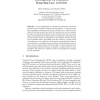Free Online Productivity Tools
i2Speak
i2Symbol
i2OCR
iTex2Img
iWeb2Print
iWeb2Shot
i2Type
iPdf2Split
iPdf2Merge
i2Bopomofo
i2Arabic
i2Style
i2Image
i2PDF
iLatex2Rtf
Sci2ools
BPM
2006
Springer
2006
Springer
Investigations on Soundness Regarding Lazy Activities
Current approaches for proving the correctness of business processes focus on either soundness, weak soundness, or relaxed soundness. Soundness states that each activity should be on a path from the initial to the final activity, that after the final activity has been reached no other activities should become active, and that there are no unreachable activities. Relaxed soundness softens soundness by stating that each activity should be able to participate in the business process, whereas weak soundness allows unreachable activities. However, all these kinds of soundness are not satisfactory for processes containing discriminator, n-out-of-m-join or multiple instances without synchronization patterns that can leave running (lazy) activities behind. As these patterns occur in interacting business processes, we propose a solution based on lazy soundness. We utilize the -calculus to discuss and implement reasoning on lazy soundness.
BPM 2006 | Business | Soundness | Soundness States | Weak Soundness |
| Added | 20 Aug 2010 |
| Updated | 20 Aug 2010 |
| Type | Conference |
| Year | 2006 |
| Where | BPM |
| Authors | Frank Puhlmann, Mathias Weske |
Comments (0)

